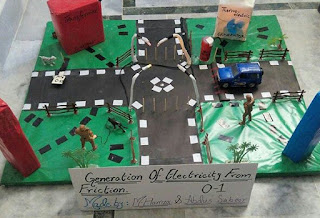This is a power project based on the fact that electricity can be generated with the help of speed breaker by making gear arrangement and using electronics gadgets, thus a huge amount of electricity can be generated saving lot of money. And if implemented will be very beneficial.
This is the new method of electricity generation,This project is about GENERATION OF ELECTRICITY with the SPEED BREAKERS. Generally when vehicle is in motion it produces various forms of energy like, due to friction between vehicle’s wheel and road i.e. rough surface heat is produced.An energy crisis is any great bottleneck in the supply of energy resources to an economy.It usually refers to the shortage of oil and additionally to electricity or other natural resources. An energy crisis may be referred to as an oil crisis, petroleum crisis, energy shortage, electricity shortage electricity crisis.
This project will work on the principle of “POTENTIAL ENERGY TO ELECTRICAL ENERGY CONVERSION”Potential energy can be thought of as energy stored within a physical system. This energy can be released or converted into other forms of energy, including kinetic energy. It is called potential energy because it has the potential to change the states of objects in the system when the energy is released If h is the height above an arbitrarily assigned reference point.
Kinetic energy of an object is the extra energy which it possesses due to its motion. It is defined as the work needed to accelerate a body of a given mass from rest to its current velocity. Having gained this energy during its acceleration, the body maintains this kinetic energy unless its speed changes. Negative work of the same magnitude would be required to return the body to a state of rest from that velocity. The kinetic energy can be calculated using the formula:In this project a mechanism to generate power by converting the potential energy generated by a vehicle going up on a speed breaker into kinetic energy.
When the vehicle moves over the inclined plates, it gains height resulting in increase in potential energy, which is wasted in a conventional rumble strip When the breaker come down, they crank a lever fitted to a ratchet-wheel type mechanism (a angular motion converter).This in turn rotates a geared shaft loaded with recoil springs. The output of this shaft is coupled to a dynamo to convert kinetic energy into electricity.A vehicle weighing 1,000 kg going up a height of 10 cm on such a rumble strip produces approximately 0.98 kilowatt power. So one such speed-breaker on a busy highway, where about 100 vehicles pass every minute, about one kilo watt of electricity can be produced every single minute.
Knowledge of following terms is very useful while making project.
TUTORIAL LINK: New idea can be made like the project above. Batteries can be attached to the street lights. So when the car passes the speed breaker the lights will start by the button in the transformer.






